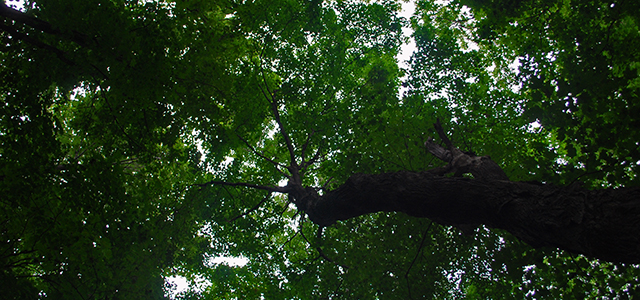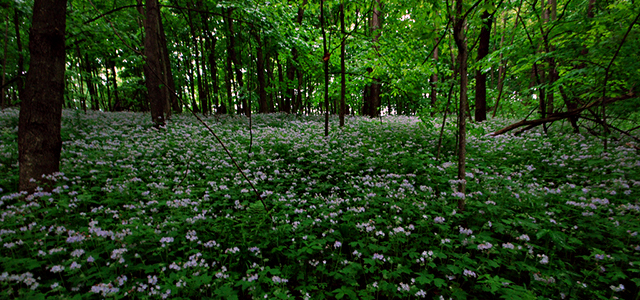The Tension Zone
A line called the tension zone (TZ) runs diagonally across Wisconsin from the northwest to the southeast. On the west side of the TZ the net annual evapotranspiration (evaporation of water by heat and wind plus transpiration of water by vegetation) exceeds the net annual precipitation (rain and snowfall). Because of the lower availability of moisture the natural communities west of the tension TZ burn more easily and are usually adapted to fire. East of the TZ, the situation is reversed with net annual precipitation exceeding net annual evapotranspiration. Here the conditions conducive to wildfire are infrequent and most of the natural communities are easily damaged by fire.
Southern Mesic Forest
When European settlers first arrived in Wisconsin, a tenth of the state (3,432,000 acres) lay in the deep shade of sugar maple-basswood-beech forest. The settlers called this forest the "Big Woods", while ecologists call it "southern mesic forest" (SMF). SMF was once common in the southern two thirds of Wisconsin, southeast Minnesota, eastern Iowa, northern Indiana, Ohio and parts of the Appalachians. Although SMF cannot tolerate fire, it is found on both sides of the TZ in Wisconsin. West of the TZ it occurs in ravines and north facing slope which stay cool and moist as well as on the leeward sides of lakes and rivers where wildfires, carried along by the prevailing winds from the west, can not reach. The word “mesic” refers to soil that is well drained but consistently moist, not dry. SMFs occur primarily on upland sites with rich loamy soils over loess deposits or glacial till.
Impact of Sugar Maple on Light and Microclimate in Southern Mesic Forest
Sugar maple reaches its highest abundance in the state in SMF where it has a profound impact on the character of the community. It casts the most shade of any native deciduous Wisconsin tree so its dominance in SMF along with basswood (which also blocks a lot of sunlight) makes SMF the darkest of any of the forest types in the state. Beech is also a co-dominant tree in some stands and doesn’t block as much sunlight but is only found in the cooler region along Lake Michigan. Other trees of SMF include red oak, musclewood, ironwood, yellowbud hickory, white ash, red maple, and slippery elm. The canopy cover in SMF is so dense by midsummer that light only reaches the forest floor in small patches. This dense canopy creates a microclimate within the forest where the air is cooler and much more humid than above the canopy and in nearby open areas. The deep shade and microclimate have driven the evolution of a number specialized plants and animals.

The patchy canopy caused by the thick foiliage of the sugar maple is a hallmark of a southern meisc forest. Photo: Joshua Mayer
Plant Adaptations to Low Light in Southern Mesic Forest
By midsummer SMF is very dark and the understory appears relatively empty except for a thick carpet of leaf litter. The most common plant adaptation to cope in this dimly lit forest is an ephemeral growth pattern. Dutchman’s breeches, spring beauty, trout lily, wood anemone, Virginia bluebells, wild leek, wild garlic, and other true ephemerals rapidly grow, store energy, and flower during a narrow window of time when sunlight reaches the forest floor between the last snows of winter and the leafing out of the trees. Ephemeral plants must grow, store food, and flower while sunlight is available on the forest floor. They then go to seed and retreat into a dormant state as bulbs, corms, tubers and rhizomes until the next spring.
Plants like white trillium, bloodroot, mayapple, various violets, Virginia waterleaf and others are true shade plants. They also emerge early in spring and take advantage of the sunlight for rapid growth and blooming but their large leaves allow them to continue to capture more light energy and photosynthesize through the summer and fall even in the low light (although some do go dormant by late summer, especially in drought years).
Shrubs, sedges, ferns, asters, goldenrods, and other plants that need brighter light tend to grow in or near canopy gaps or large openings where trees have fallen due to disease, lightning, and/or wind. Evidence is mounting that the seeds of many species of sedges have the remarkable ability to lie dormant in the soil for the life span of a large tree - up to 3 centuries! When a disturbance allows a significant amount of sunlight to reach the soil in which the seeds have laid dormant the seeds germinate and the plants may thrive for a couple decades until they get shaded out again by new trees, after which their seeds wait patiently for another disturbance. Still other sedge species persist as small populations of plants in the deep shade but don’t really thrive and multiply until canopy gaps form.
The saplings of sugar maple, basswood, and beech trees are extremely shade tolerant and can grow slowly in the gloom for several decades waiting for an opening to form in the canopy at which point they grow very rapidly to try and fill it. The saplings of other trees like yellowbud hickory and white ash can live in dark shade for a few years but then die if an opening does not occur. Saplings of red oak will not live for more than a year or two in deep shade.

Virginia waterleaf (hydrophyllum virginianum) thrives in the shade of the forest floor. Photo: Joshua Mayer
Conservation of Southern Mesic Forest
Over the last two centuries SMF has been significantly reduced by logging and clearing of land for farms, roads, and development. As SMF has become more and more fragmented the ratio of forest edge to forest interior has increased. The more “edge” there is to these forests the more vulnerable the forest is to drying out by wind and sunlight thus reducing its microclimate that is so important to plants (and amphibians). Other edge effects include increased vulnerability to invasion by exotic species and easier access to the interior by predators such as raccoons and coyotes as well as herbivores such as white tailed deer and eastern cottontail. These predators and herbivores were historically forest edge and savanna species and their populations have increased in response to fragmentation. The increased presence of predators is especially significant for forest nesting bird species like the wood thrush, Louisiana waterthrush, and Kentucky warbler which need very large tracts of closed canopy forest to nest successfully. Fragmentation has also isolated populations of organisms, rendering them vulnerable to local extinction, loss of genetic diversity through genetic drift, and inbreeding depression do to loss of gene flow.

From left to right: Wood thrush (Hylocichla mustelina), Kentucky Warbler (Oporornis formosus), Louisiana Waterthrush (Seiurus motacilla). Photos: Kelly Colgan Azar, Don R. Faulkner.
In addition to the plants already mentioned, SMF is home to rare plants such as forked aster, golden seal, American ginseng, twinleaf, handsome sedge, blue stemmed golden rod, blackhaw viburnum and blue ash. Rare mammals include the grey wolf, eastern red bat, flying squirrel, and woodland jumping mouse, while the four toed salamander, timber rattlesnake, and black rat snake are a few of the uncommon herptiles that call SMF home. To learn more about these and other rare plants, mammals, reptiles, amphibians, and birds associated with SMF click here.
It is important that we preserve and expand all remaining tracts of Southern Mesic Forest to save the plants and animals that live there and as carbon sinks to sequester carbon dioxide to mitigate climate change. Seminary Woods and Grant Park are two places in Milwaukee where one can find magnificent relicts of SMF. Enter this world of green shadows and you can enjoy the flourish of tens of thousands of spring wildflowers, listen to the cerulean warbler and the wood peewee, or sit in humble silence under centuries-old trees.





